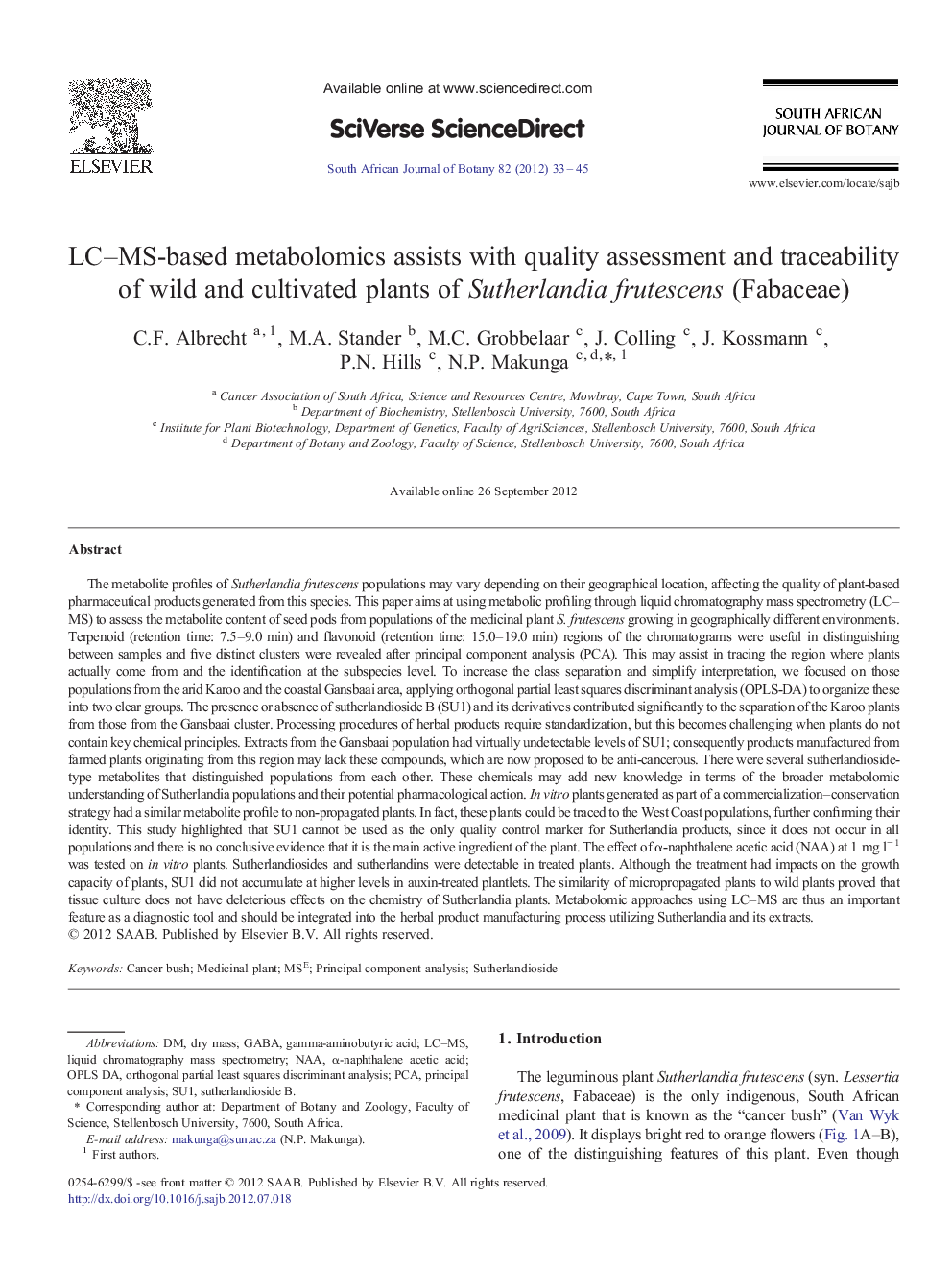| کد مقاله | کد نشریه | سال انتشار | مقاله انگلیسی | نسخه تمام متن |
|---|---|---|---|---|
| 4520968 | 1625176 | 2012 | 13 صفحه PDF | دانلود رایگان |

The metabolite profiles of Sutherlandia frutescens populations may vary depending on their geographical location, affecting the quality of plant-based pharmaceutical products generated from this species. This paper aims at using metabolic profiling through liquid chromatography mass spectrometry (LC–MS) to assess the metabolite content of seed pods from populations of the medicinal plant S. frutescens growing in geographically different environments. Terpenoid (retention time: 7.5–9.0 min) and flavonoid (retention time: 15.0–19.0 min) regions of the chromatograms were useful in distinguishing between samples and five distinct clusters were revealed after principal component analysis (PCA). This may assist in tracing the region where plants actually come from and the identification at the subspecies level. To increase the class separation and simplify interpretation, we focused on those populations from the arid Karoo and the coastal Gansbaai area, applying orthogonal partial least squares discriminant analysis (OPLS-DA) to organize these into two clear groups. The presence or absence of sutherlandioside B (SU1) and its derivatives contributed significantly to the separation of the Karoo plants from those from the Gansbaai cluster. Processing procedures of herbal products require standardization, but this becomes challenging when plants do not contain key chemical principles. Extracts from the Gansbaai population had virtually undetectable levels of SU1; consequently products manufactured from farmed plants originating from this region may lack these compounds, which are now proposed to be anti-cancerous. There were several sutherlandioside-type metabolites that distinguished populations from each other. These chemicals may add new knowledge in terms of the broader metabolomic understanding of Sutherlandia populations and their potential pharmacological action. In vitro plants generated as part of a commercialization–conservation strategy had a similar metabolite profile to non-propagated plants. In fact, these plants could be traced to the West Coast populations, further confirming their identity. This study highlighted that SU1 cannot be used as the only quality control marker for Sutherlandia products, since it does not occur in all populations and there is no conclusive evidence that it is the main active ingredient of the plant. The effect of α-naphthalene acetic acid (NAA) at 1 mg l− 1 was tested on in vitro plants. Sutherlandiosides and sutherlandins were detectable in treated plants. Although the treatment had impacts on the growth capacity of plants, SU1 did not accumulate at higher levels in auxin-treated plantlets. The similarity of micropropagated plants to wild plants proved that tissue culture does not have deleterious effects on the chemistry of Sutherlandia plants. Metabolomic approaches using LC–MS are thus an important feature as a diagnostic tool and should be integrated into the herbal product manufacturing process utilizing Sutherlandia and its extracts.
► Distinct chemical differences were identified in Sutherlandia populations.
► Variable sutherlandin and sutherlandioside content explained PCA and OPLS-DA groups.
► LC–MS-based metabolomics is a powerful quality control tool for herbal products.
Journal: South African Journal of Botany - Volume 82, September 2012, Pages 33–45